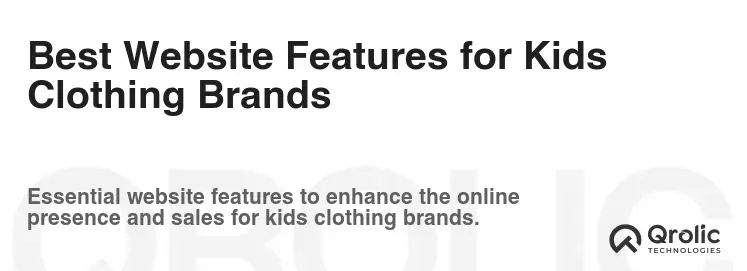Quick Summary:
- Prioritize a detailed, helpful size guide.
- Use high-quality, real-life product visuals.
- Build trust with safety and ethical info.
- Ensure easy navigation and mobile experience.
Table of Contents
- Best Website Features for Kids Clothing Brands
- Understanding the Unique Landscape of Kids’ Fashion E-Commerce
- The Foundation: Essential E-Commerce Store Features
- Level Up: Kids’ Fashion Specific Features for Your Ecommerce Store
- 1. The All-Important Size Guide: Demystifying Children’s Clothing Sizes
- 2. High-Quality Visuals: Appealing to Parents and Capturing Children’s Attention
- 3. Streamlined Navigation and Filtering: Making the Shopping Experience Easy
- 4. Durable and Ethical Considerations: Addressing Parental Concerns
- 5. Engaging Content and Storytelling: Building a Connection with Your Audience
- 6. Personalization and Customization: Making the Experience Unique
- 7. Mobile Optimization: Catering to On-the-Go Parents
- 8. Exceptional Customer Service: Building Trust and Loyalty
- 9. Creating a Child-Friendly Atmosphere (Without Being Overly Childish):
- 10. Addressing Safety Concerns: A Top Priority
- Qrolic Technologies: Your Partner in Building a Winning Kids Fashion Website
- Key Takeaways and Actionable Steps
Best Website Features for Kids Clothing Brands

Understanding the Unique Landscape of Kids’ Fashion E-Commerce
The world of kids’ fashion e-commerce is a vibrant, competitive space. Parents, grandparents, and gift-givers are constantly on the lookout for stylish, durable, and affordable clothing for the little ones in their lives. However, buying clothes online for children presents unique challenges. Unlike shopping for adults, sizes are less standardized, preferences are rapidly changing, and the ultimate user (the child) often has little to no input in the purchasing decision.
Therefore, a successful kids’ clothing brand website needs to go beyond the standard e-commerce template. It needs to build trust, offer exceptional convenience, and create an enjoyable shopping experience that appeals to both the buyer (the adult) and, ideally, captures the imagination of the child. The goal? Convert browsing into sales and, more importantly, cultivate loyal, returning customers.
The Foundation: Essential E-Commerce Store Features
Before diving into the specifics tailored for kids’ fashion, let’s solidify the bedrock upon which a successful website is built – the essential e-commerce features:
-
Responsive Design: This is non-negotiable. Your website must look and function flawlessly on all devices: desktops, tablets, and smartphones. Mobile-friendliness is paramount, as a significant portion of online shopping happens on mobile devices. Google prioritizes mobile-first indexing, so a responsive design directly impacts your search engine ranking.
-
High-Quality Product Photography: Visuals are king! Use professional-quality photos showcasing clothing from multiple angles, including close-ups of details like fabric texture, stitching, and embellishments. Consider using 360-degree views and videos to provide a more immersive experience.
-
Detailed Product Descriptions: Don’t skimp on information. Include fabric composition, care instructions, sizing details (more on this later), country of origin, and any unique features of the garment. Write in a clear, concise, and engaging style that appeals to parents. Use keywords naturally within the descriptions to improve search engine visibility.
-
Secure Payment Gateway: Security is paramount. Choose a reputable payment gateway that offers robust security measures, such as SSL encryption, to protect customer data. Display security badges prominently to build trust.
-
Clear and Concise Shipping Information: Be upfront about shipping costs, delivery times, and return policies. Transparency builds trust and reduces customer frustration. Offer multiple shipping options to cater to different needs and budgets.
-
Easy Navigation and Search Functionality: Make it easy for customers to find what they’re looking for. Implement a well-organized category structure and a powerful search function with filters for size, color, style, price range, and other relevant attributes.
-
Customer Reviews and Ratings: Social proof is a powerful motivator. Encourage customers to leave reviews and ratings on your products. This builds trust and provides valuable feedback for your business. Actively respond to reviews, both positive and negative, to demonstrate that you value customer opinions.
-
Wishlist Feature: Allow customers to save their favorite items for later purchase. This is especially useful for parents who may want to consult with others before making a decision or wait for a sale.
-
Account Creation and Management: Enable customers to create accounts to save their shipping addresses, payment information, and order history. This streamlines the checkout process and encourages repeat purchases.
Level Up: Kids’ Fashion Specific Features for Your Ecommerce Store
Now, let’s delve into the features that are specifically crucial for kids’ fashion websites and will help your e-commerce store stand out:
1. The All-Important Size Guide: Demystifying Children’s Clothing Sizes
The biggest pain point for parents buying clothes online is sizing. Children’s sizes are notoriously inconsistent across brands, making it difficult to determine the right fit. A comprehensive and user-friendly size guide is absolutely essential.
-
Detailed Measurement Charts: Provide clear and accurate measurement charts for each size, including height, chest, waist, and hip measurements. Consider offering separate charts for boys and girls, as body proportions can differ.
-
Age-Based Sizing with Caveats: While age-based sizing (e.g., “Size 4 for 4-year-olds”) is a common starting point, emphasize that it’s just a guideline. Include a disclaimer stating that children’s growth rates vary and that measurements should always be used as the primary reference.
-
Conversion Charts: If you sell internationally, provide conversion charts to translate sizes between different regions (e.g., US, UK, EU).
-
Visual Aids: Use illustrations or diagrams to show parents where to measure their child accurately. A simple diagram showing where to measure the chest, waist, and inseam can be incredibly helpful.
-
Product-Specific Sizing Notes: Include sizing notes within the product descriptions themselves. If a particular garment runs small or large, mention it clearly. If the fabric is stretchy or non-stretchy, indicate how that might affect the fit.
-
Interactive Size Finder: Consider implementing an interactive size finder that asks parents for their child’s measurements and then recommends the appropriate size. This can be a valuable tool for reducing returns due to sizing issues.
-
Customer Feedback on Sizing: Prominently display customer reviews and ratings that mention sizing. This provides valuable insights from other parents about how the garment fits in real life.
-
“How to Measure” Videos: Create short, informative videos demonstrating how to measure a child for clothing. Visual guides are often easier to understand than written instructions.
-
Example: Imagine a product description for a pair of toddler jeans. The size guide section might include: “Our toddler jeans are designed with a relaxed fit for comfort and play. Please refer to the chart below for accurate sizing. Note: These jeans run slightly long. If your child is between sizes, we recommend sizing down.” Then, a detailed chart would follow, listing measurements for each toddler size.
2. High-Quality Visuals: Appealing to Parents and Capturing Children’s Attention
Visual appeal is crucial for kids fashion websites. You need to grab the attention of both the parents who are making the purchase and, ideally, the children who will be wearing the clothes.
-
Lifestyle Photography: Showcase clothing in real-life settings. Instead of just featuring a garment on a mannequin, show children wearing the clothes while playing, running, or engaging in other activities. This helps parents visualize how the clothes will look on their own children.
-
Multiple Angles and Zoom Functionality: Provide multiple photos of each garment from different angles. Allow customers to zoom in on details like fabric texture, stitching, and embellishments.
-
360-Degree Views: Offer 360-degree views of key items, such as dresses, jackets, and shoes. This provides a more comprehensive view of the product and helps customers make informed decisions.
-
Videos: Use videos to showcase clothing in motion. This is especially effective for demonstrating the fit and movement of activewear. Consider creating videos that feature children interacting with the clothes, such as twirling in a dress or showing off the pockets in a pair of pants.
-
Appealing to Children’s Tastes: Use bright colors, playful backgrounds, and engaging props in your product photography. Consider featuring children of diverse ethnicities and abilities.
-
Collaboration with Child Influencers: Partner with popular child influencers to showcase your clothing on social media and in your product photography. This can help you reach a wider audience and build credibility.
-
Virtual Try-On (Advanced): While still an emerging technology, consider implementing a virtual try-on feature that allows customers to see how the clothes would look on their child using augmented reality.
3. Streamlined Navigation and Filtering: Making the Shopping Experience Easy
Parents are busy! Make it easy for them to find what they’re looking for quickly and efficiently. A well-designed navigation system and robust filtering options are crucial.
-
Clear and Intuitive Category Structure: Organize your products into logical categories, such as “Girls,” “Boys,” “Toddlers,” “Babies,” “Outerwear,” “Dresses,” “Pants,” “Shoes,” and “Accessories.”
-
Detailed Filtering Options: Provide a wide range of filtering options, including size, color, style, price range, material, season, occasion, and special features (e.g., organic cotton, waterproof, UPF protection).
-
“Shop by Age” or “Shop by Size” Options: Create dedicated sections where customers can browse products specifically for their child’s age or size.
-
“Shop the Look” Feature: Create curated outfits and allow customers to purchase the entire look with a single click. This can be a great way to showcase your products and inspire customers.
-
Personalized Recommendations: Use data to provide personalized product recommendations based on customers’ past purchases and browsing history.
-
Search Bar with Auto-Suggest: Implement a search bar with auto-suggest functionality to help customers find what they’re looking for quickly and easily.
-
Mobile-Friendly Navigation: Ensure that your navigation system is optimized for mobile devices. Use a hamburger menu or other mobile-friendly navigation elements to conserve screen space.
4. Durable and Ethical Considerations: Addressing Parental Concerns
Parents are increasingly concerned about the durability and ethical sourcing of children’s clothing. Highlight these aspects prominently on your website.
-
Detailed Fabric Information: Provide detailed information about the fabric composition of each garment, including its durability, breathability, and care requirements.
-
Care Instructions: Include clear and concise care instructions to help parents keep their children’s clothes looking their best.
-
Ethical Sourcing Information: Be transparent about your ethical sourcing practices. If you use organic cotton, fair trade practices, or other sustainable materials, highlight this information prominently.
-
Certifications and Accreditations: Display any relevant certifications or accreditations, such as GOTS (Global Organic Textile Standard) or Fair Trade certification.
-
Durability Guarantee: Consider offering a durability guarantee on certain items. This demonstrates your confidence in the quality of your products.
-
Partnerships with Ethical Manufacturers: Highlight your partnerships with ethical manufacturers who prioritize fair labor practices and environmental sustainability.
-
Blog Posts and Articles on Sustainable Fashion: Create blog posts and articles on sustainable fashion and ethical sourcing to educate your customers and demonstrate your commitment to these values.
5. Engaging Content and Storytelling: Building a Connection with Your Audience
Go beyond simply selling clothes. Create engaging content that resonates with your audience and builds a connection with your brand.
-
Blog Posts on Parenting and Fashion: Write blog posts on topics relevant to parenting and children’s fashion, such as tips for dressing your child for different occasions, advice on choosing the right shoes, or inspiration for creating stylish outfits.
-
Style Guides and Lookbooks: Create style guides and lookbooks that showcase your clothing in creative and inspiring ways.
-
Behind-the-Scenes Content: Share behind-the-scenes content about your brand, such as the design process, the manufacturing process, or the people who work at your company.
-
Customer Testimonials and Stories: Feature customer testimonials and stories on your website and social media channels.
-
Contests and Giveaways: Run contests and giveaways to engage your audience and generate excitement about your brand.
-
Interactive Quizzes: Create interactive quizzes, such as “What’s Your Child’s Style?” or “What’s the Perfect Outfit for a Playdate?”
-
Partnerships with Parenting Blogs and Websites: Partner with popular parenting blogs and websites to promote your brand and reach a wider audience.
6. Personalization and Customization: Making the Experience Unique
Offer personalized experiences and customization options to make your customers feel special and valued.
-
Personalized Recommendations Based on Past Purchases: Provide personalized product recommendations based on customers’ past purchases and browsing history.
-
Customizable Clothing Options: Allow customers to customize certain items, such as adding their child’s name or initials.
-
Personalized Emails: Send personalized emails to customers based on their interests and purchase history.
-
Birthday Discounts and Offers: Send birthday discounts and offers to customers on their child’s birthday.
-
Loyalty Programs: Implement a loyalty program to reward repeat customers and encourage them to continue shopping with your brand.
7. Mobile Optimization: Catering to On-the-Go Parents
As mentioned before, mobile optimization is non-negotiable, but it deserves a specific call-out in the context of kids’ fashion e-commerce stores. Parents are often shopping on the go, using their smartphones while waiting in line, commuting, or during their children’s activities.
-
Responsive Design: Ensure that your website looks and functions flawlessly on all mobile devices.
-
Fast Loading Speeds: Optimize your website for fast loading speeds on mobile devices.
-
Mobile-Friendly Navigation: Use a hamburger menu or other mobile-friendly navigation elements to conserve screen space.
-
Touch-Friendly Interface: Design your website with a touch-friendly interface that is easy to use on mobile devices.
-
Simplified Checkout Process: Streamline the checkout process for mobile users.
-
Mobile App (Optional): Consider developing a mobile app for your brand to provide an even more seamless shopping experience.
8. Exceptional Customer Service: Building Trust and Loyalty
Exceptional customer service is crucial for building trust and loyalty with your customers.
-
Multiple Contact Options: Provide multiple contact options, such as email, phone, and live chat.
-
Fast Response Times: Respond to customer inquiries quickly and efficiently.
-
Friendly and Helpful Customer Service Representatives: Train your customer service representatives to be friendly, helpful, and knowledgeable about your products.
-
Easy Returns and Exchanges: Offer easy returns and exchanges.
-
Proactive Customer Service: Reach out to customers proactively to offer assistance or address any concerns.
-
Customer Feedback Surveys: Send customer feedback surveys to gather feedback and identify areas for improvement.
9. Creating a Child-Friendly Atmosphere (Without Being Overly Childish):
Finding the right balance is key. The website is for parents, but a nod to the child’s perspective can enhance the experience.
-
Subtle Use of Playful Elements: Incorporate subtle playful elements into your website design, such as whimsical fonts, fun illustrations, or engaging animations. However, avoid making the website too childish, as this may alienate parents.
-
Age-Appropriate Content: Ensure that all content on your website is age-appropriate.
-
Parental Controls (If Applicable): If you offer any interactive features, such as games or quizzes, consider implementing parental controls to ensure that children are using them safely.
-
Focus on Fun and Playfulness: Highlight the fun and playful aspects of your clothing. Emphasize how your clothes can help children express their creativity and imagination.
10. Addressing Safety Concerns: A Top Priority
Parents are understandably concerned about the safety of their children’s clothing.
-
Compliance with Safety Standards: Ensure that all of your clothing complies with relevant safety standards, such as CPSIA (Consumer Product Safety Improvement Act) in the United States.
-
Non-Toxic Materials: Use non-toxic materials in your clothing and avoid using any harmful chemicals.
-
Choking Hazard Warnings: Include choking hazard warnings on any items that may pose a choking risk to young children.
-
Secure Fastenings: Use secure fastenings on your clothing to prevent them from coming loose and posing a safety hazard.
-
Flame-Resistant Fabrics: Consider using flame-resistant fabrics in your clothing, especially for sleepwear.
Qrolic Technologies: Your Partner in Building a Winning Kids Fashion Website
At Qrolic Technologies (https://qrolic.com/), we understand the unique challenges and opportunities of the kids’ fashion e-commerce market. We offer a comprehensive suite of services to help you build a successful online business, from website design and development to SEO and digital marketing.
-
E-commerce Website Development: We specialize in building custom e-commerce store solutions tailored to your specific needs and budget. We use the latest technologies and best practices to create websites that are visually appealing, user-friendly, and optimized for conversions.
-
SEO Services: Our SEO experts will help you optimize your website for search engines, so you can attract more organic traffic and reach a wider audience. We’ll conduct keyword research, optimize your website content, and build high-quality backlinks to improve your search engine ranking.
-
Digital Marketing Services: We offer a full range of digital marketing services, including paid advertising, social media marketing, email marketing, and content marketing. We’ll work with you to develop a customized marketing strategy that will help you reach your target audience and achieve your business goals.
-
Mobile App Development: If you’re looking to create a mobile app for your brand, our experienced app developers can help you bring your vision to life. We’ll develop a custom app that is optimized for both iOS and Android devices.
-
Ongoing Support and Maintenance: We provide ongoing support and maintenance services to ensure that your website is always running smoothly and securely. We’ll also provide regular updates to keep your website up-to-date with the latest technologies and security patches.
We are committed to providing our clients with the highest quality services and helping them achieve their business goals. Contact us today to learn more about how we can help you build a winning kids’ fashion website. We can help with everything from setting up a robust size guide to implementing engaging features.
Key Takeaways and Actionable Steps
Building a successful kids’ fashion website requires more than just a standard e-commerce setup. You need to understand the unique needs and concerns of parents, provide a seamless and enjoyable shopping experience, and build trust with your audience.
Here’s a summary of actionable steps you can take to improve your website:
- Prioritize the Size Guide: Invest time and effort in creating a comprehensive and user-friendly size guide that includes detailed measurement charts, visual aids, and product-specific sizing notes.
- Invest in High-Quality Visuals: Use professional-quality photos and videos to showcase your clothing in real-life settings.
- Streamline Navigation and Filtering: Make it easy for customers to find what they’re looking for with a well-organized category structure and robust filtering options.
- Highlight Durability and Ethical Considerations: Be transparent about your ethical sourcing practices and the durability of your products.
- Create Engaging Content: Go beyond simply selling clothes and create engaging content that resonates with your audience.
- Personalize the Experience: Offer personalized recommendations and customization options to make your customers feel special and valued.
- Optimize for Mobile: Ensure that your website is optimized for mobile devices.
- Provide Exceptional Customer Service: Respond to customer inquiries quickly and efficiently and offer easy returns and exchanges.
- Create a Child-Friendly Atmosphere (Subtly): Incorporate subtle playful elements into your website design.
- Address Safety Concerns: Ensure that all of your clothing complies with relevant safety standards and use non-toxic materials.
By implementing these strategies, you can create a kids’ fashion website that attracts more customers, builds brand loyalty, and drives sales. Remember, the key is to focus on providing value to your customers and creating a positive shopping experience. Good luck!






